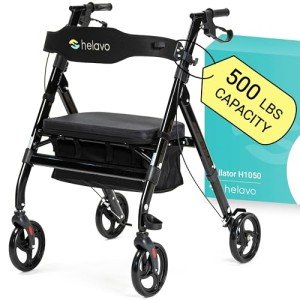7 Simple Secrets To Totally Rocking Your Stable 4-Wheel Walker
The Stability of 4-Wheel Walkers: A Comprehensive Guide
A stable 4-wheel walker can change mobility for people experiencing difficulties with balance and coordination. These devices, frequently called rollators, can be essential tools in regaining self-reliance for those recovering from surgery, conquering age-related constraints, or handling chronic conditions. This blog site looks into the features, advantages, and considerations one should bear in mind when choosing a 4-wheel walker, supplemented with useful tables and a Frequently Asked Questions (FAQ) area to improve understanding.
Why Choose a 4-Wheel Walker?
A 4-wheel walker uses several advantages over conventional walking help, such as walking sticks or walkers with just 2 wheels. Below are a few of the key advantages:
Benefits of a 4-Wheel Walker
Advantage
Description
Improved Stability
The four wheels supply a stable base, enabling simpler navigation throughout various surfaces.
Improved Mobility
The designs are generally lighter and simpler to maneuver, permitting users to move with self-confidence.
Integrated Sit-Down Feature
Numerous 4-wheel walkers come with an integrated seat, using users the alternative to rest when required.
Storage Options
A lot of walkers include storage bags or baskets for individual items, increasing freedom for users.
Adjustable Height
Lots of designs offer height modifications to accommodate different user heights, providing convenience throughout use.
Braking System
The majority of walkers come geared up with hand brakes, allowing the user to safely stop and lock the walker in place.
Types of 4-Wheel Walkers
4-wheel walkers come in numerous designs and performances to deal with different user requirements. Below is a classified table:
Type
Description
Requirement Rollators
Basic designs developed for general mobility. Frequently Walking Aid With Seat and foldable.
Heavy-Duty Rollators
Designs constructed to support larger weights (up to 500 pounds or more). Ideal for much heavier users.
Dual Brake Rollators
Offer both hand brakes and parking brakes for enhanced safety, specifically beneficial for elderly users.
Folding Walkers
Compact designs that quickly fold for transport and storage. Perfect for those who take a trip or have actually restricted space.
Specialty Rollators
Equipped with distinct features such as built-in lights, larger seats, or particular designs for certain conditions like arthritis.
Secret Features to Consider
When selecting a stable 4-wheel walker, it is essential to pick a design that fits the user's requirements. Here are some essential features to consider:
- Weight Capacity: Always check the optimum weight limitation.
- Height Adjustability: Ensure that it can be adapted to fit the user's height.
- Wheel Size: Larger wheels offer much better ability over rough surfaces, while smaller wheels are great for indoor use.
- Seat Height and Comfort: If the design includes a seat, inspect its height and cushioning.
- Braking Mechanism: Look for reliable brakes that are easy to operate.
- Reduce of Folding: Users ought to easily fold and unfold the walker for transport.
- Storage Solutions: Evaluate storage options like seat pouches and under-seat baskets.
- Product and Durability: Consider walkers made with durable products to make sure longevity.
Popular Models on the marketplace
Here's a selection of popular models currently readily available, showcasing their distinct features and requirements:
Model
Weight Capacity
Seat Height
Features
Drive Medical Nitro
300 pounds
23.5”
Lightweight, easy-to-fold design, big wheels.
Medline Ultralight
300 pounds
23”
Integrated seat, adjustable handles, storage pouch.
Nova Zoom 4
300 lbs
22-24”
Dual brakes, padded seat, easy to fold.
BABY JOY 4-Wheel
300 lbs
20-23”
Lightweight aluminum frame, storage basket, ergonomic handles.
How to Use a 4-Wheel Walker
Knowing how to use a 4-wheel walker successfully is necessary for making the most of security and mobility. Here's a step-by-step guide:
- Position the Walker: Stand behind the walker, with the handlebars at hip height.
- Adjust for Comfort: Make sure the height suits your convenience for standing and walking.
- Engage Brakes: Before sitting, engage the brakes to make sure the walker does stagnate.
- Step Forward: Move the walker forward, making sure all four wheels touch with the ground.
- Walk Naturally: Use a natural walking rhythm, moving the walker forward and stepping the system as required.
- Rest: When fatigued, locate a seat on the walker, engage the brakes, and sit conveniently.
FAQ
1. What is the perfect height for a 4-wheel walker?
- The handlebars ought to be at waist level when the person is standing directly. The majority of walkers provide adjustable heights to accommodate this.
2. Can a 4-wheel walker be used outdoors?
- Yes, lots of designs are designed for outdoor use, including bigger wheels for better navigation over uneven terrains.
3. How do you keep a 4-wheel walker?
- Routinely examine the wheels, brakes, and frame for wear and tear. Clean surfaces to remove debris, and ensure the brakes function correctly.
4. Exist insurance benefits for acquiring a 4-wheel walker?
- Many insurance coverage strategies cover walkers if recommended by a doctor. Always check your particular strategy information.
5. What is the typical cost of a 4-wheel walker?
- Costs may differ commonly, from approximately ₤ 50 for fundamental designs to over ₤ 300 for more advanced styles.
A stable 4-wheel walker can significantly add to an individual's mobility, confidence, and quality of life. By considering the features, types, and perfect usage strategies talked about above, individuals can make educated choices that best fit their needs. Whether it's for healing, aging, or managing ongoing health conditions, selecting the right walker can cause a healthier and more active lifestyle.
